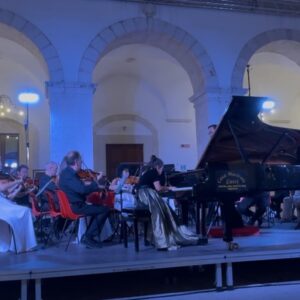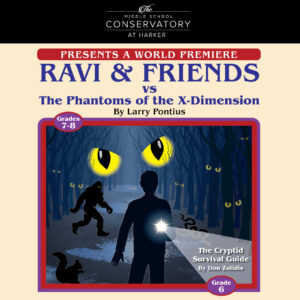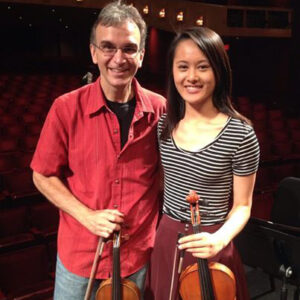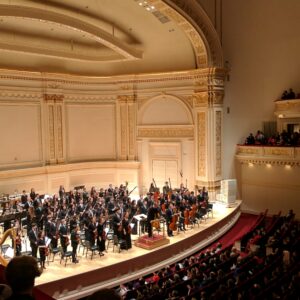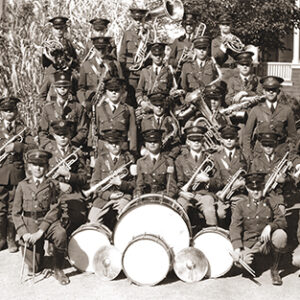The upper school Orchestra is going to New York! The group, led by director Chris Florio, will travel in April to compete in the National Orchestra Cup at Alice Tully Hall in Lincoln Center. The hall just completed a $100 million renovation and is considered one of the top performance halls in the country.
“I have wanted to take the orchestra to New York for a couple of years,” said Florio. “Through research, I found out about the National Orchestra Cup and decided that competing in a newly renovated space like Alice Tully Hall would be a great opportunity.”
The group had to apply and pass a review before being green-lighted for the competition, said Florio. “There are several schools entered this year that I am familiar with, and their programs are going to be very challenging to compete against,” he noted.
Although the orchestra traveled to Eastern Europe in 2005 with a score of students, and to Paris in 2006 with almost twice that number, “this will be the first orchestra competition for Harker,” said Florio. “We will be taking 68 students to perform. We have had chamber groups participate in competitions in the past but those were with only a handful of students.”
One of those 68 students will be violinist Sonya Huang, Gr. 11. She started playing at Harker eight years ago. “I started off learning under Toni Woodruff, a Bucknall strings coach at Harker,” said Huang. “About a year later, I switched to an outside private teacher, and I’m currently studying under Li Lin, a teacher at the San Francisco Conservatory.”
Huang has been in first the middle school, then the upper school orchestras since Gr. 4. She made the Eastern European tour, seeing Prague, Vienna and Budapest with the upper school Orchestra while she was still in Gr. 7 and went on the Paris tour in Gr. 9.
“I’m looking forward to attending its third-ever tour,” said Huang. “We attend the CMEA (California Music Educators’ Association) orchestra competition every year, but that is a relatively small-scale competition. I’ve never par ticipated in a large orchestra competition before, and I think that this will be a great experience for all Harker orchestra members. It’s really such an honor that Harker has been chosen to participate in the National Orchestra Cup this year.”
Huang noted it won’t be all work. “We’ve scheduled many fun activities to do in New York, ranging from watching a performance by the New York Philharmonic, to touring New York landmarks, to shopping on Fifth Avenue,” she said. Then there is the event. “It’s going to be really thrilling to play in that famous venue, as many famous orchestras and musicians have played on that very stage. I’m especially looking forward to the competition because it’s a great chance to showcase our orchestra’s talent and hard work from the entire year.
“We’ll be playing some Copland, as well as a piece I originally recommended to Mr. Florio, Smetana’s “Ma Vlast.” To me, the latter is an especially beautiful work, and I love everything about the piece, from the flowing melody in the first violin sections to the dance-like motifs later on in the piece. So performing “Ma Vlast” on stage will definitely be one of the highlights of the competition for me! Of course, it would be great to win a trophy, but regardless of whether we win any awards, I believe that we’ll all gain extremely valuable performance experience, and of course, cherished tour memories,” Huang added.
It’s early days, and the group hasn’t felt the pinch of time yet. “There hasn’t been that much added pressure,” said Huang. “Sure, we’ve had our fair share of bad rehearsals, but we’ve also had many, many successful rehearsals as well. Mr. Florio hasn’t star ted tearing out his hair yet at our intonation, so I’d say we’re on the right track!”
The orchestra will have 25 minutes to perform and Florio selected Bedrich Smetena’s “The Moldau” from “Ma Vlast” and Aaron Copland’s “Saturday Night Waltz” and “Hoe Down” from “Rodeo” for their program, and “the toughest par t is definitely in the preparation of all the pieces,” said Huang. “When working on orchestral masterworks such as the Smetana, it’s difficult, with so many members of the orchestra, to convey the single unified idea that the conductor wants. Everyone has a slightly different interpretation of the piece at first, but we try our best to match up to the conductor’s interpretation of the music. And of course, sight-reading and learning the notes is difficult when we first receive the music, but eventually, with lots of hard practice, we’ll have the pieces down.”
Florio is intent on challenging his students. “I believe that Harker students work best when they have a competitive drive (so) I am anxious to see how far we can push ourselves, and how we stack up against other groups around the country.” Watch for updates on this adventure!


